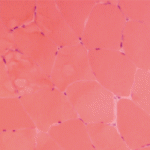Andrew Mammen, MD, PhD, an investigator with the National Institute of Arthritis and Musculoskeletal and Skin Diseases, stood next to a slide listing 40 medications—all of which can cause myotoxicity.
“This is just a partial list,” Dr. Mammen said. Statins are prominent on the list because they’re so widely prescribed—13 million Americans are treated with them and to great benefit.
But, Dr. Mammen said, 5–10% of patients develop myalgias, and about 0.5% will develop CK elevations. Symptoms tend to go away after statins are stopped, but it can sometimes take as long as a year.
Certain statins come with greater risk of causing myopathy.
“Not all statins are created equal,” Dr. Mammen said. Those metabolized through the CYP3A4 pathway in the liver are more myotoxic, and those that aren’t are less so. Part of the reason for this is probably because so many other drugs are also metabolized through this pathway, he said, including HIV protease inhibitors. One study found that those given simvastatin had a 3,000% increase in statin concentration after HIV protease inhibitors were added. However, patients taking either of two other statins actually saw decreased statin concentrations after HIV protease inhibitors were added.1
Genetics can also increase the risk for developing myopathy. A genome-wide association study of 12,000 patients found that a single SNP—one found in organic anion-transporting polypeptide (OATP1B1), which regulates the hepatic uptake of statins—had a strong correlation for statin-induced myopathy, accounting for 60% of the incidence of statin toxicity in the patients.2
Also, Dr. Mammen said, the SNP distinguishes between the C allele and the T allele—and those with the CC genotype are at the highest risk of myopathy development.
“It won’t surprise me if we start to look for this genotype before prescribing statins to patients,” he said, because it could mean those patients should get a lower dose.
He also talked about the discovery of autoantibodies to HMG-CoA reductase (HMGCR), the pharmacological target of statins, in necrotizing myopathy patients. The investigation began with a 71-year-old man who had started a statin and developed myopathy symptoms, but the symptoms did not dissipate once the statin was stopped.
Through further studies, researchers found that this type of myopathy is rare, but for patients who have it, treatment is required. A study of 12 patients found that immunosuppressive treatment, mostly prednisone along with other therapies, lowered creatinine kinase levels and increased strength. Anti-HMGCR levels were lowered, but not reduced to normal levels.3

